 Thanks: 0
Thanks: 0
 Needs Pictures: 0
Needs Pictures: 0
 Picture(s) thanks: 0
Picture(s) thanks: 0
Results 1 to 15 of 32
Thread: To float or to rasp,
-
15th November 2013, 07:47 PM #1
 To float or to rasp,
To float or to rasp,
In regards to cutting wood ,what is the difference between using a rasp or a float .
Or more to the point ,how does a float perform compared to rasp .
Having never used a float ,and only ever used a rasp, a few times ,and then not a high quality one (baco) but it was new although .
Do floats perform better, or is it that they perform in a different manner , as I suspect.
It also seems that u would be able to sharpen a float ,were as I never seen ,or read of being able to re sharpen a rasp ,other than cleaning with a file card ,tho I stand to be corrected on that point.
-
15th November 2013 07:47 PM # ADSGoogle Adsense Advertisement
- Join Date
- Always
- Location
- Advertising world
- Posts
- Many
-
15th November 2013, 08:08 PM #2

G'day Matt
IanW will give you the definitive answer, but in the mean time, they are just different. A float is essentially a milled file with perpendicular rather than oblique teeth, and less hard (files are around 62-65 Rc and floats about 54 Rc). This is so that a float can be sharpened with a saw file (not all that frequently though).
Floats can be used in all sorts of ways, but they are generally (always?) flat. They will give a superior finish to a rasp, particularly when you go obliquely across end grain (like when shaping a saw handle). However, rasps are more suitable for most tasks in shaping a saw handle because of the variety of shapes and grains (coarsness/fineness) they are available in.
HTH
Brett
-
15th November 2013, 08:43 PM #3
 .
.











- Join Date
- Feb 2006
- Location
- Perth
- Posts
- 27,794

Rasps have thousands of individual pointed teeth where as floats have parallel rows of teeth.
The teeth on floats are not usually milled perpendicular but like rasps usually have a positive rake.
About 5 years ago I made a set of floats - have a look here for the WIP.
Derek Cohen has used these to make a few things.
One more difference between floats and rasps is that floats have a straight edge so are restricted to forming convex surfaces whereas half round rasps can form concave surfaces.
-
15th November 2013, 10:51 PM #4

Hi Guys, I liken a float to a multi blade scraper rather than a rasp. A scraper draws off that little thin wisp of wood. A float
a (sharp one) takes multiple little wisps of wood and as FF said really only for flat work. I use my rasps a lot and the floats very little but
still handy to have in the arsenal. That reminds me FF didn't we have an order in with Mr Gordon or did we not get the numbers.
-
16th November 2013, 07:06 AM #5

You mean for HSS floats? No, not enough numbers.
-
17th November 2013, 08:19 AM #6

Hey, I'm no guru, FF! What you all said has nailed it. I look on floats as tools for refining flat surfaces that you can't get a plane onto, but they have other uses, I'm sure.
Claw, I think of a float as a file with very large teeth rather than a set of scraper blades, only because the teeth on a float aren't as controlled as the edge of a burnished scraper in my hands. You can get some alarming dig-ins if you go over an edge carelessly.
Floats are at their best cutting obliquely across end grain, as on the blade-bed of a wooden plane, for e.g. Not so hot planing side-grain, because there is not much control over chipping ahead of any cutting tooth, other than any pressure from the tooth in front. They will work ok on many woods, but make a mess on some. Here, a rasp, with it's many teeth, does a more controllable, albeit rougher job. P'raps it was rasps that inspired toothed plane blades?
Cheers,IW
-
17th November 2013, 01:24 PM #7
 Senior Member
Senior Member











- Join Date
- Dec 2009
- Location
- Mandurah WA
- Age
- 60
- Posts
- 351

I recently saw a pic of a cobblers float. It had a short convex blade about the size and shape of those small surform tools.
The body files that panel beaters used to use are a type of float and they can be convex in length or in width IIRC.

Steve.
-
17th November 2013, 08:42 PM #8

I was at my weekend retreat this weekend
That's were my creative zone is
And being an ex beater(panel beater )
Was going to have a look at my body files
And well um was gonaa sort of I forgot ok
But I was thinking exactly the same
And being attached to a flex handle could be quite handy
And the blades are not that expensive
-
17th November 2013, 10:42 PM #9

I went in to My local Total Tools a while back a they had a box of new old stock, Nicholson floats , the exact name on the box escapes me ? Lead float possibly ? . Ive seen plenty of old ones over the years but these were new and sharp. The same looking tooth profile as a Plane Makers float except the tooth crossed the face of the float in a curve , with a guess a 30mm radius.
Any way I bought a few with the intention of cutting it to a plane makers float shape. I think it will work fine. I made some a while back but the plane making project stalled One day soon .
One day soon .
Playing with them a bit I would say on a flat surface they are slow to remove material , with many teeth resting on the same level you can change flat angles but it takes a few strokes with some pressure . But on a surface that has been created say with a chisel or a drill , like in roughing out the innards of a plane body, the removal of the high parts down to a flat is rapid and true's it all up . For shaping outside corners of stock they work well leaving a smoother finish than a rasp.
I was at the Melbourne hand tool swap meet last week and saw some Gun stock floats , two of them ,a bit like a pipe with teeth and a cranked handle for seating a gun barrel by the looks of it. There is always something I regret not asking "How much" after I walk from there. still cant think what I would be able to do with them though
Rob
-
17th November 2013, 11:54 PM #10
 .
.











- Join Date
- Feb 2006
- Location
- Perth
- Posts
- 27,794

Lee Valley has the Nicholson float- well its really more of file than a float. NicholsonŪ Milled-Tooth Files - Lee Valley Tools
I have a couple of similar files with curved teeth from Bahco - I think these are designed more for panel beating Bahco Digital Catalogue - English
The problem with all the curved teeth hobbies is they are a bit "hard" to resharpen.
-
18th November 2013, 01:21 AM #11

Yeah Bob your right there ! little curved stones ?
Simplicity asked about sharpening rasps. As has been discussed before, old files can be sharpened chemically by cleaning and soaking in Vinegar/ Acetic acid I think it was . It works , I tried it . One of the incredible things learned on line.
Possibly rasps and curved floats should work as well with the same treatment. Maybe only once or twice . They probably wont be as true as a filed one.
Rob
-
18th November 2013, 09:20 AM #12

In the recent saw files testing there were half a dozen files that had a duplicate (unmarked) file that had been treated with citric acid. In every case except one (as I recall) the acid treated file had a significantly poorer performance than the original file. All the files were new and unused. The acid treated files felt significantly sharper to the touch, but the performance was quite notably less, particularly in terms of corner teeth fracturing and roughness of use. The one treated file that got a better score than it's untreated counterpart only did so because the original was deemed to be a POS anyway. It was still a "fail", just slightly less of one.
The object of that part of the exercise was to see if there was any basis to the claim that files can either be successfully sharpened (either old or new) by acid baths. The answer was a resounding "waste of time because the performance was worse to non-existant".
I cannot see a rasp would be any different in terms of what happens to the metal. It may not affect performance as much given that it is used on wood rather than metal. The rasp will feel sharper to the touch after acid bathing, but this is misleading, based upon the results.
The report is here.
-
18th November 2013, 10:15 AM #13

My attempt seemed like the file was improved . I suppose this could just have been because it was just a lot cleaner ? It started out as a slightly rusted choked up thing.
Rob
-
18th November 2013, 10:25 AM #14

It may depend on the aggressivenessof the acid and duration of the bath (as well as the temperature). That is to say that a weaker bath and/or shorter duration may only be doing just what you said - cleaning it properly, and not removing any metal from the teeth. Either way, it would only be something I would do on a file or rasp where I had nothing to lose.
-
18th November 2013, 10:37 AM #15

A cross between a rasp, file, or float. Known as IWASAKI File from Japan.
I want to jump in here since Iīm hooked with those tools.
When I read the first time that those carving files should work quick like rasps but precise like files by leaving a smooth surface, I couldnīt believe it. It sounded a little bit exaggerated. Since I need to have good tools for shaping saw handles, I was interested although. Fine-Tools sent me two of those and I tested them for a review in the German forum woodworking. de. That to be said, I want to share my experience with those tools.
The files look a little bit unusual, the cutting edges are interrupted by skew channels and the half round file isnīt flat at the back, itīs concave and smooth.
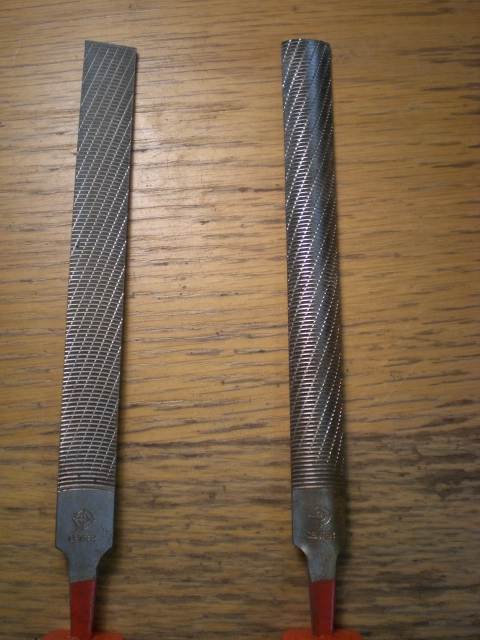
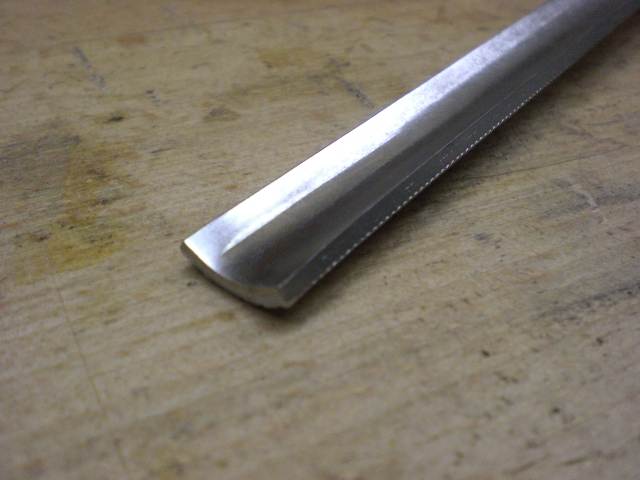
Thereīs another thing thatīs not to see. The edges are shaped with little chip breakers. The amazing result: the file doesnīt produce dust but little shavings. 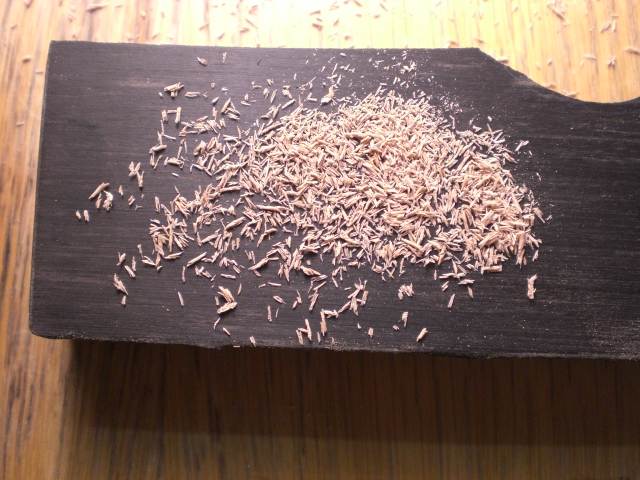
To compare the speed of the tool I shaped one edge of the handle with a coarse rasp and the other with the carving file. The surprising result was, that there is no speed difference. The carving file is as quick as my coarsest rasp, perhaps even a little bit faster. It feels a little unusual because the carving file wants to go a little bit skew. You can force it to work with a straight cut but then it works a little rough. If you let it work how it wants, it is easy to steer and works very smooth. Youīve to take care not to remove more stock than you want. Very amazing. The following pics show that the surface the carving file leaves is way better than the rasp can do.
Pear:
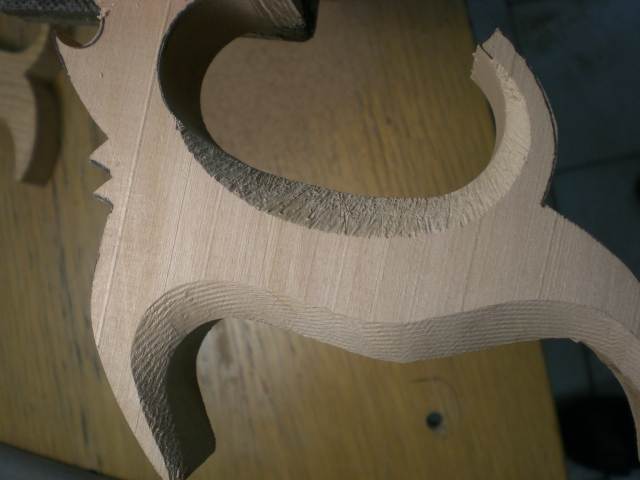
Wenge:
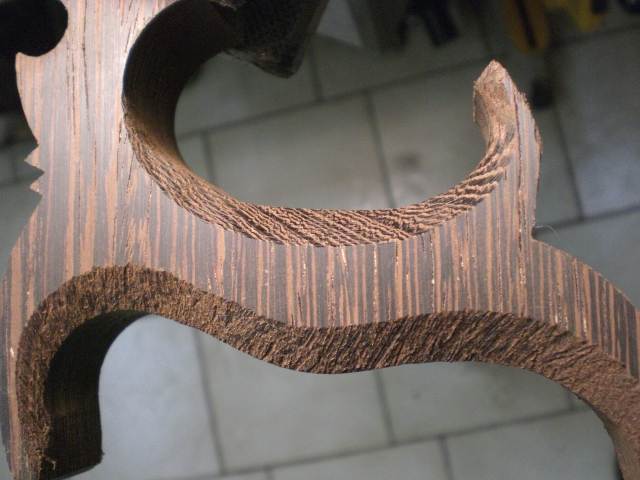
Maple:
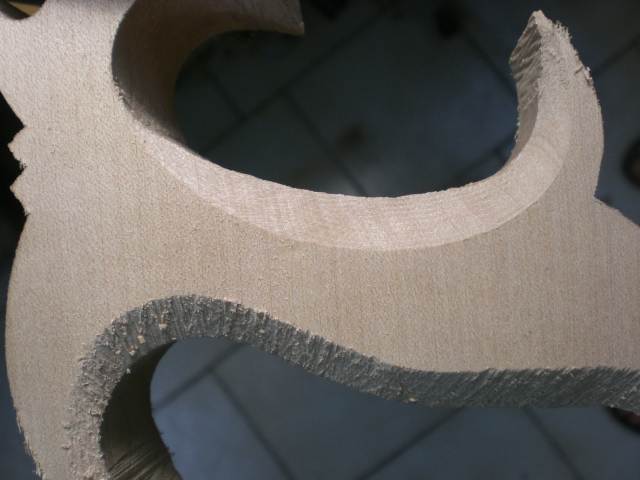
I think that the pics are speaking for themselves. After this test I wanted to know, if the carving file was able to do the fine work too. So I worked on one side of a Pear blank only with this tool. It worked fine.

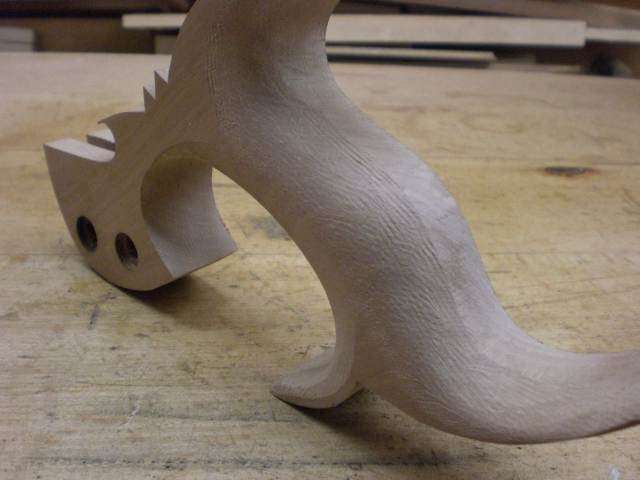
At last a pic of three saw handles that were made by using the carving files.
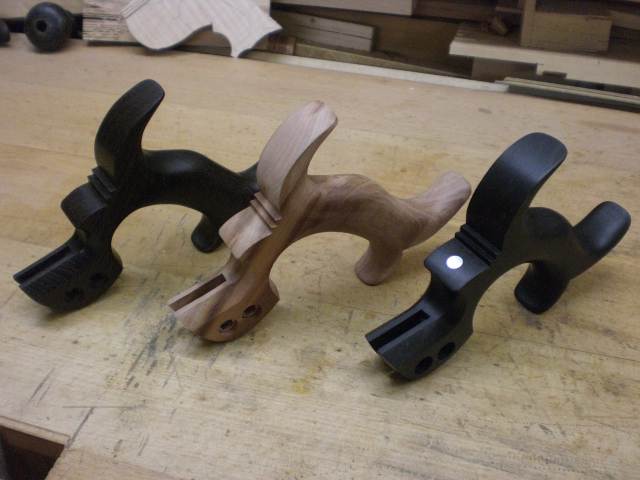
Actually the carving file replaced the coarse rasp when I make saw handles. Itīs at least as quick but better to steer and leaves a better surface. Itīs one of the tools Iīd hate to miss. IMO, you can`t get a better shaping tool for the money.
Klaus
Thank you all.
Two things I wanted to add after working with these files for about 9 months now.
The first is, that the tools keep their cutting edges very well. They are in heavy use, I work with them nearly daily only on hard woods. Actually the cutting speed is not slower than 9 months ago.
The second, I want to mention is, that the files are cleaning themselves while cutting. I never worked with files before that needed less care on cleaning than these ones.
Klaus..Live a Quiet Life & Work with your Hands
Similar Threads
-
Plane makers float
By auscab in forum HAND TOOLS - UNPOWEREDReplies: 13Last Post: 9th January 2013, 08:50 PM -
What machine to sharpen a Float?
By FenceFurniture in forum METALWORK FORUMReplies: 5Last Post: 28th September 2012, 04:44 PM -
Austalian hardwoods that float
By nutter11 in forum TIMBERReplies: 8Last Post: 21st July 2010, 01:07 AM -
Orse float repairs
By Iain in forum WOODWORK - GENERALReplies: 3Last Post: 29th April 2002, 05:31 PM



 Likes:
Likes: 

 Reply With Quote
Reply With Quote

